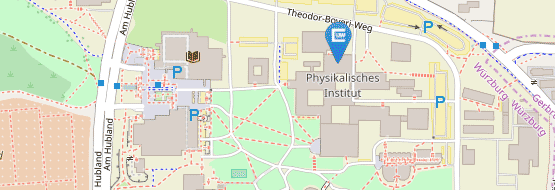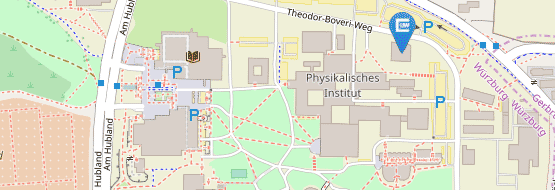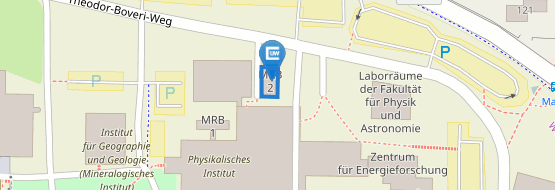Publications
Magnetic Particle Imaging: Publications
-
iMPI: portable human-sized magnetic particle imaging scanner for real-time endovascular interventions. . In Sci. Rep., 13(1), p. 10472. 2023.
-
Detection of viral antibodies in camel sera using magnetic particle spectroscopy. . In Appl. Microbiol. Biotechnol., 107(10), pp. 3329–3339. 2023.
-
Magnetic particle imaging for artifact-free imaging of intracranial flow diverter stents: A phantom study. . In Phys. Med., 88, pp. 65–70. 2021.
-
Synomag®: The new high-performance tracer for magnetic particle imaging. . In Int. J. Magn. Part. Imag., 7(1), p. 2103003. 2021.
-
Near real-time magnetic particle imaging for visual assessment of vascular stenosis in a phantom model. . In Phys. Med., 81, pp. 210–214. 2021.
-
Adjustable Hardware Lens for Traveling Wave Magnetic Particle Imaging. . In IEEE Trans. Magn., 56(11), p. 5300506. 2020.
-
A dynamic bolus phantom for the evaluation of the spatio-temporal resolution of MPI scanners. . In J. Magn. Magn. Mater., 519, p. 167446. 2020.
-
Novel Fabrication Method for Nested Saddle Coils. . In IEEE Trans. Magn., 56(9), pp. 1–6. 2020.
-
Crosslinked Coating Improves the Signal-to-Noise Ratio of Iron Oxide Nanoparticles in Magnetic Particle Imaging (MPI). . In Chem. Nano. Mat., 6(5), pp. 755–758. Wiley, 2020.
-
Parallel magnetic particle imaging. . In Rev. Sci. Instrum., 91(4), p. 045117. American Institute of Physics, 2020.
-
Superspeed Bolus Visualization for Vascular Magnetic Particle Imaging. . In IEEE Trans. Med. Imag., 39(6), pp. 2133–2139. 2020.
-
Micro-Traveling Wave Magnetic Particle Imaging - Sub-Millimeter Resolution With Optimized Tracer LS-008. . In IEEE Trans. Magn., 55(10), p. 5300207. 2019.
-
Magnetic Particle Imaging meets Computed Tomography: first simultaneous imaging. . In Sci. Rep., 9(1), p. 12627. 2019.
-
Magnetic Particle Imaging-Guided Stenting. . In J. Endovasc. Ther., 26(4), pp. 512–519. 2019.
-
Novel Field Geometry UsingTwo Halbach Cylinders for FFL-MPI. . In Int. J. Magn. Part. Imag., 4(2), p. 1811004. 2018.
-
Magnetic Particle Imaging Guided Real-Time Percutaneous Transluminal Angioplasty in a Phantom Model. . In Cardiovasc. Intervent. Radiol., 41(7), pp. 1100–1105. 2018.
-
Nanopartikel weisen den Weg - Medizinische Bildgebung mit Magnetpartikeln. . In Physik in unserer Zeit, 49(3), pp. 131–137. 2018.
-
Dynamic Linear Gradient Array for Traveling Wave Magnetic Particle Imaging. . In IEEE Trans. Magn., 54(2), p. 5300109. 2018.
-
Magnetic Particle Imaging for Quantification of Vascular Stenoses: A Phantom Study. . In IEEE Trans. Med. Imag., 37(1), pp. 61–67. 2018.
-
Selective Signal Suppression in Traveling Wave MPI: Focusing on Areas with Low Concentration of Magnetic Particles. . In Int. J. Magn. Part. Imag., 3(2), p. 1709001. 2017.
-
Low Latency Real-time Reconstruction for MPI Systems. . In Int. J. Magn. Part. Imag., 3(2), p. 1707002. 2017.
-
Real-time 3D Dynamic Rotating Slice-Scanning Mode for Traveling Wave MPI. . In Int. J. Magn. Part. Imag., 3(2), p. 1706001. 2017.
-
Novel Reconstruction Techniques and Applications for Magnetic Particle Imaging. . In Int. J. Magn. Part. Imag., 2(2), p. 1703000. 2017.Editorial
-
Flexible and Dynamic Patch Reconstruction for Traveling Wave Magnetic Particle Imaging. . In Int. J. Magn. Part. Imag., 2(2), p. 1611001. 2016.
-
First in vivo traveling wave magnetic particle imaging of a beating mouse heart. . In Phys. Med. Biol., 61(18), pp. 6620–6634. 2016.
-
Numerical Simulations of 3D Rotational Drift. . In Int. J. Magn. Part. Imag., 2(1), p. 1607001. 2016.
-
Magnetic Particle Imaging. . In Z. Med. Phys., 25(1), pp. 1–2. 2015.Forum
-
Rotating Slice Scanning Mode for Traveling Wave MPI. . In IEEE Trans. Magn., 51(2), p. 6501503. 2015.
-
μMPI - Initial Experiments With an Ultrahigh Resolution MPI. . In IEEE Trans. Magn., 51(2), p. 6502104. 2015.
-
Superspeed Traveling Wave Magnetic Particle Imaging. . In IEEE Trans. Magn., 51(2), p. 6501603. 2015.
-
Bimodal TWMPI-MRI Hybrid Scanner - Coil Setup and Electronics. . In IEEE Trans. Magn., 51(2), p. 5300504. 2015.
-
Simulating the Signal Generation of Rotational Drift Spectroscopy. . In IEEE Trans. Magn., 51(2), p. 6500704. 2015.
-
Rotational Drift Spectroscopy for Magnetic Particle Ensembles. . In IEEE Trans. Magn., 51(2), p. 6500604. 2015.
-
MRI Meets MPI: A Bimodal MPI-MRI Tomograph. . In IEEE Trans. Med. Imag., 33(10), pp. 1954–1959. 2014.
-
Traveling Wave Magnetic Particle Imaging for determining the iron-distribution in rock. . In diffusion-fundamentals.org, 22(12), pp. 1–5. 2014.
-
Traveling Wave Magnetic Particle Imaging. . In IEEE Trans. Med. Imag., 33(2), pp. 400–407. 2014.










